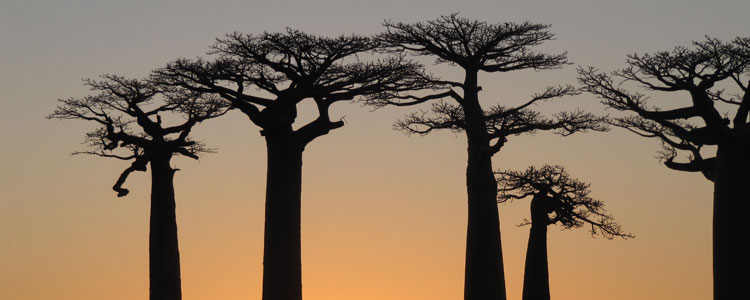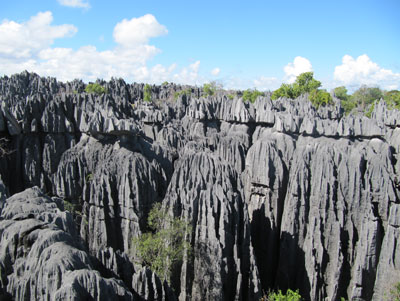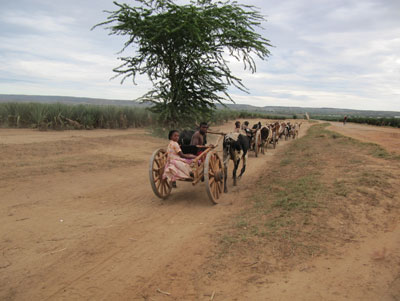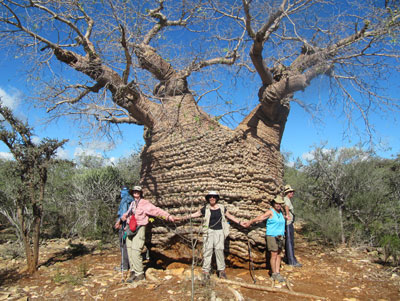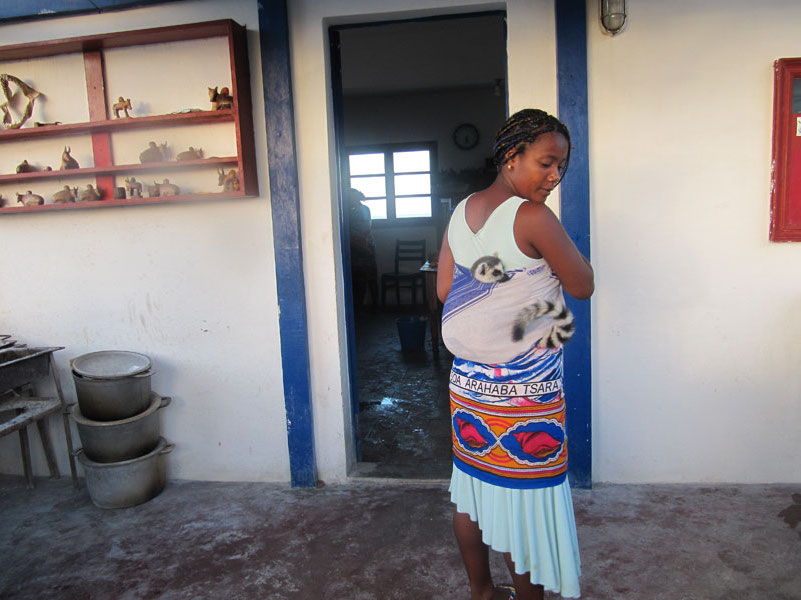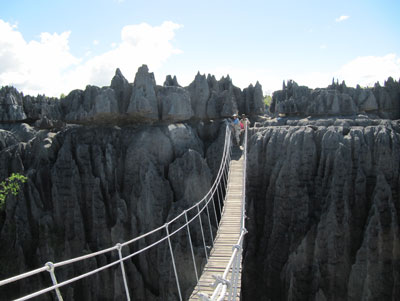Magnificent Madagascar
By Nili Olay; New York, NY
Madagascar, the land of lemurs and baobab trees, wasn’t even on our short list of places to visit. Furthermore, we don’t like group tours. Yet my husband, Jerry, and I traveled to Madagascar as part of a group of 10 from May 16 to June 9, 2010. Why?
When an e-mail arrived in my inbox from Galapagos Travel announcing a trip to this fascinating country, we realized that, unlike the itineraries of most packaged tours, this one provided three or four nights at most locations, and the 3½-week tour would give us an opportunity to see quite a bit of the country.
We had gone to the Galápagos (January 2004) and Antarctica (January 2007) with Galapagos Travel and found it a wonderful company to work with. We also admire the company’s eco-ethics and their commitment to conservation. With this opportunity to go to Madagascar with them, we couldn’t resist signing up.
An overview
I am delighted that we went on this trip. The country, with its unique wildlife and colorful history and cultures, was fascinating. Be advised, however: Madagascar is a difficult place to visit, primarily because of the state of its roads and the undependable flight schedules.
It took 3½ hours to drive the 50 bumpy miles from Fort Dauphin (Tolagnaro) to Berenty Reserve and took 10 hours each way on bumpy roads to get from Morondava to Bekopaka. It was well worth it but grueling.
During our trip, we covered diverse topography: the rainforests in the Masoala and Perinet regions in eastern Madagascar; the desert at the Berenty Reserve in the southeast; the lovely beaches of Ambola in the southwest, and the limestone karst landscape — the Tsingy — in the west.
Our accommodations varied by location, ranging from camps to very comfortable lodgings. This was an active trip, including prebreakfast and nocturnal nature hikes as well as daytime activities whenever possible. There was some free time scheduled, and, of course, we always had the option to pass on an activity.
Masoala Peninsula
We began the trip with an overnight flight on Air Madagascar (Air Mad) from Paris, arriving in Antananarivo (Tana) at 4 a.m. Our connecting flight to Maroansetra was scheduled for 7 a.m. but was delayed till noon, which meant spending our first morning in Madagascar in the airport. The flight to Maroansetra was pleasant and short.
We were met at the airport and taken to the port for our one-hour boat trip to Masoala Forest Lodge, located in the Masoala National Park, for a three-night stay.
Having traveled for 24 hours, we waded off the boat at Masoala and saw a bit of paradise.
Masoala Forest Lodge is surrounded by rainforest, which stretches almost to the beach itself. The lodge is made up of five double safari-style tents, each with adjoining private toilet/shower facilities. Each cabin also has a pleasant front porch and a small area in back with a hammock. The dining room/meeting room was open and airy.
Since it had taken so long to get to the lodge, our first scheduled event was a nocturnal nature walk. There is something magical about walking through the forest, in light rain, with flashlights, spotting a leaf-tailed gecko, a frog or the eyes of a mouse lemur (two red spotlights at the top of a tree).
The next morning, after a good night’s sleep and a delicious breakfast, we were ready to see more of the rainforest. We hiked a short distance from the camp and learned about the area’s medicinal plants. We did not see much wildlife because it was raining pretty hard for most of the hike.
The afternoon was free for snorkeling, swimming or just resting. Since it was still raining, I chose the latter.
The following morning dawned sunny and warm, and our schedule included both hiking and canoeing. Floating on the river and looking for birds was very peaceful.
During the hike, we saw a ring-tailed mongoose run across the trail. It was much larger than I expected. We also saw a red-ruffed lemur and a giant day gecko.
We had most of the afternoon to ourselves, and this time I went swimming in the calm, warm waters of Antongil Bay. In the late afternoon, the village women came to sing and dance; it was a charming performance.
In the morning we returned to Maroansetra and flew on to Tana.
Antananarivo
Anyone traveling to Madagascar will probably visit Tana multiple times during their trip. It has the only international airport, and most flights to other Malagasy cities fly in and out of its domestic terminal.
We stayed at the lovely Pavillon de l’Emyrne each time we arrived in town. The hotel is on a quiet street, but it’s still within easy walking distance of areas of interest. Starting life as a 1930s-style house, the building has been beautifully restored and includes a magnificent garden in its courtyard. Each room is unique, spacious and pleasant.
A short walk away from the hotel is Ku de Ta (16 Rue de la Reunion; phone 261 20 22 281 54), where we ate multiple times. The food at Ku de Ta was delicious, and the service, unlike at most places we visited in Madagascar, was efficient and pleasant.
Also within walking distance are shopping areas offering both tourist and local items.
The most interesting sightseeing trip we took while in Tana was to the old palace, just outside the city, built by king Andrianampoinimerina, who unified the country. Just a one-room house, it is the burial place of the king, along with his father and wives, and is considered a holy site.
Berenty Private Reserve
Our next adventure took place at the Berenty Private Reserve. We flew from Tana to Fort Dauphin and drove 50 bumpy miles to the reserve. The roads have not been repaved in 50 years, but the long ride was definitely worthwhile. The wildlife and the spiny forest in Berenty were amazing.
A troupe of ring-tailed lemurs greeted our van upon arrival, and it only got better from there.
Berenty was as different from Masoala as night is from day. The weather was dry and the terrain, sandy and level. During our two-night stay we went on morning, afternoon and evening nature walks. (It was supposed to be a three-night stay, but Air Mad changed flight times, so we had to change our itinerary.)
We saw many types of lemurs, but the one that was the most fun to watch was the Verreaux’s sifaka. These sifakas are mostly white, with black faces, and they hop like kangaroos, only sideways. When they reach their destined tree, they seem to just lift themselves up effortlessly. It was a treat to watch all the various lemurs scurry up and down the trees.
The ring-tailed lemurs were very bold, venturing on to the furniture in our breakfast room. They liked to sun themselves and sat with legs and arms spread out.
We enjoyed delightful walks in the spiny forest. The trees were unlike any that I had seen before. I especially liked the “octopus tree,” its many branches intertwined in interesting patterns.
On to Ambola
Getting from place to place in Madagascar is always an adventure. Our next stop, Ambola and the nearby Tsimanampetsotsa National Park, was no exception.
We flew from Tana to Toliara and were transferred by van and zebu carts to a boat, which was docked about a mile offshore due to the low tide.
After a very wet, one-hour boat ride, we transferred to a four-wheel-drive vehicle for the 1½-hour ride to our beach resort, Domaine d’Ambola.
We were supposed to have two vehicles, but one was stuck in the mud somewhere, so 11 of us plus the driver piled into the one vehicle. It was an exceedingly uncomfortable 1½ hours, but we made the best of it, singing songs and laughing a bit.
Domaine d’Ambola is located on a magnificent white sandy beach on the Indian Ocean. As soon as I saw the resort and the beach, my travel fatigue disappeared.
The staff at the resort had adopted an orphaned ring-tailed lemur that they named Tobi. He was still very young and obviously had the run of the place. We had to ask that he be kept away at mealtimes, otherwise he stole food from our hands, so one of the staff members would keep him in a sling on her back. He seemed to love it and would go right to sleep with his tail hanging out of the sling.
About two miles from the resort is Tsimanampetsotsa National Park, which encompasses a salt lake that is home to greater flamingos for half the year. They were in residence while we visited.
We also visited a cave with blind fish (completely white), but the most exciting sight was the ancient baobab trees. We heard conflicting information, but the “Grandma baobab” there, which is all wrinkled and stooped over, is said to be about 3,000 years old. Other trees are about 1,000 years old. I am thrilled that they have been protected in the national park.
To tour the park, we traveled the local way, in zebu carts. The ride was extremely bumpy and uncomfortable on the park’s rocky paths. The four-wheel-drive vehicle that picked us up for the return to the resort felt luxurious in comparison.
The Tsingy
Getting to Berenty and Ambola was difficult, but it was nothing compared with getting to the amazing Tsingy area near Bekopaka. We took a one-hour flight from Toliara to Morondava, then drove through the Avenue of the Baobabs and on as far as the Kirindy Forest Reserve, where we stopped for the night.
Our Kirindy Lodge cabins were basic (no en suite facilities in most cabins), but the stay there enabled us to see more varieties of lemurs as well as the fosa (pronounced “fusa”), one of the few lemur predators. A fosa is the size of a medium dog but resembles a cat, somewhat. A couple of them nonchalantly walked into camp.
We also saw the giant jumping rat, which is the size of a large rabbit. It is not often seen, but the camp is on its nocturnal route.
As usual, we went on a night hike, on which we saw mouse lemurs and red-spotted lemurs. They were just darling, each small enough to hold in the palm of your hand. We also saw chameleons, nocturnal geckos and an owl.
Our guides were just amazing, spotting these animals in the dark (with the help of head lamps). Most of the guides we had in the various camps were not college educated, but they had learned from botanists who passed through the camps and they knew all the common and Latin names for the plants and their medicinal uses.
After breakfast the next day, we began the long ride to the Tsingy area, which required two ferry crossings. The 40-minute ferry trip was the only smooth ride of the day.
About nine exhausting hours later we arrived at the beautiful Hotel l’Orchidee just outside Bekopaka. The hotel was surrounded by flowers, and the cabins were comfortable, with reliable hot showers.
The Tsingy reserve, a UNESCO World Heritage Site, is made up of beautiful jagged formations of limestone karst that have been carved by nature over millions of years. During our three days in the area, we hiked in both the Petite and Grand Tsingys and explored the Tsingy caves on the river in pirogues.
Hiking the Petite Tsingy was invigorating and interesting but not very difficult. However, hiking in the Grand Tsingy is not for the faint of heart.
We wore harnesses with carabiners, which we hooked onto wires bolted into the rocks. The climbing involved finding footholds and pulling ourselves up by the jagged rocks. We were advised to use gardening gloves to hold onto the rocks, and I really appreciated having them.
We crossed suspension bridges and at other times crawled on all fours to get through the caves.
We stopped at two viewing points to look at the amazing rock formations — which made it all worthwhile. The Tsingy is an absolutely beautiful place.
We hiked for almost seven hours and covered about six miles. Most of the traveling was done vertically, going up and down rocks.
Our drive to Morondava was long (10 hours), but we had the pleasure of stopping at the Avenue of the Baobabs at sunset. The magnificent baobabs line the road for about a mile.
We spent one night in Morondava at Chez Maggie, a lovely beach resort, before flying back to Tana. I would have liked to have had more time at Chez Maggie to relax on the beach and in the lovely rooms and surroundings.
Andasibe National Park
If you have only a few days to spend in Madagascar, Andasibe National Park, in the Perinet area and only a couple of hours (on paved roads) from Tana, will probably be on your itinerary. The park is in a highland rainforest and has a great deal of wildlife.
The most amazing experience at the park was hearing the call of the wonderful indri lemurs. An unearthly call, it filled the rainforest.
In addition to our walks in the park, we went to nearby Lemur Island, a refuge for former pet lemurs. They are used to humans, and some of them amused themselves by jumping on us.
We stayed at Hotel Feon’ny Ala, located just outside the park. This is a very large complex with many detached, simple cabins (which do have en suite facilities).
The details
Our trip with Galapagos Travel (Aptos, CA; 800/969-9014, www.galapagostravel.com) cost $15,790 for both of us, covering all hotels, land transportation, all food, tips to local guides and entrance fees to the parks. We paid an additional $4,300 for Air Madagascar flights (including Paris to Tana) for two people.
Our tour leader was Richard Parsons, who had lived in Madagascar for a couple of years and spoke Malagasy and French in addition to English. This enabled him to communicate our needs and smooth out any trip glitches.

